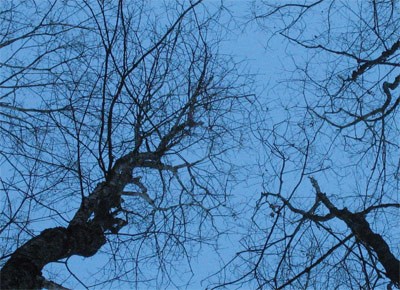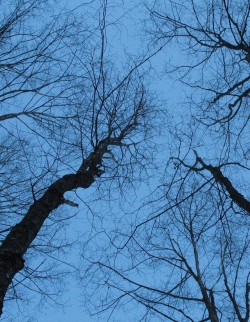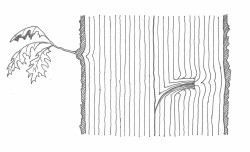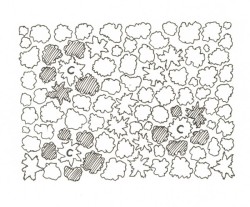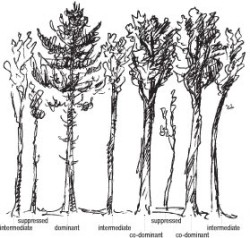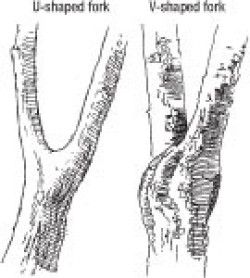If we were to arrange optimal conditions for growing the perfect tree, we would provide a site that’s a perfect match for the species’ particular needs. It would begin its life in strong competition with trees of similar size. I’m partial to sugar maple, so let’s assume the tree is a sugar maple seedling growing in a pure stand of at least 7,000 other maples on one acre. Like its cohorts, this seedling is less than one inch in diameter and stands a little more than one foot tall. It grows in these close quarters for 10 or so years and develops into a sapling. The competition forces the tree to grow straight, and as it puts on height it self-prunes, which means it sheds its lower branches because their leaves no longer receive sufficient light.
It will take another decade or two for the sapling to reach pole size – a diameter of five inches – and, adhering to Darwinian principles, the most vigorous trees will suppress the less vigorous, relegating them to the understory and then death. The process of self-pruning continues, and the sugar maple develops clear, knot-free wood in its trunk. If the lower branches were to continue living, they would show up as knots, which would reduce the tree’s utility and its value when it was cut later. Thus, competition helps produce a long, straight trunk, free of limbs for 40 feet – the ideal sawlog tree. Without competition, the maple would grow to resemble a yard tree, whose stout lower branches would entice generations of climbing children.
Standing slightly above its nearest competition, the perfect sugar maple’s expanding crown helps it continue to put on girth. Then, as if they were involved in a single-elimination tournament, the winners of each round move on to compete with each other. Instead of competing with trees two or three feet away, the tree now competes with those 8 or 10 feet away. The same condition that got the tree off to a good start – competition – fosters strong, straight, valuable growth. With the trees now 35 to 45 years old, the contest is carried out among fewer but larger trees.
At this time, when less than one-third of the tree’s height is made up of a live crown, we intervene for the first time. We’ll choose the keepers and remove those that are inferior in form. The goal of the initial thinning is to maintain the favored tree’s good growth rate by giving the crown room to expand, but not so much room that it compromises the continued development of a clear bole. If crown space is opened up too soon, the tree might develop new branches, called epicormic branches on a trunk that has already pruned itself. It is important to give each crop tree space to grow at the appropriate time. The tree will respond by expanding its crown (and thus its capacity for photosynthesis) and increasing the trunk’s diameter at a faster rate.
Fifteen or so years later, when the crop trees have tall, clear boles and the diameter growth has slowed, we intervene again by identifying the best trees and removing any competing trees that have poorly formed boles or crown structures that are compromised and at risk of splitting. Now, instead of pole sized trees, we have trees that have reached the sawtimber stage with 12-inch diameters. They are becoming more valuable each year. Given room, their growth rate increases again, and they’ll soon be ready for another thinning. Finally, when the crop tree reaches its maturity – 100 years or more for a sugar maple – it has developed into a veneer-quality tree worth hundreds of dollars. In a perfect situation, that process is happening throughout the acre, and from a starting point of more than 7,000 stems, an acre can produce 75 perfect 20-inch diameter trees. That’s a lot of value.
Normally, you’d probably work with a forester and a logger to mark and thin your trees in these periodic thinning harvests that occur throughout the entire stand. If you want to help the best trees along yourself, however, there’s an even more intensive method of management known as crop-tree release that you can use in those areas that have the best potential. If you have good skills with a chainsaw and can reliably fall trees in the direction you choose, this can be a very rewarding use of your time.
Chances are you have at least some trees that are on their way to being high-quality sawlog or veneer trees. The nearer they are to reaching this potential, the more obvious they will be. The 18-inch black cherry that’s straight as a gun barrel will doubtless catch your eye. Or maybe there’s a large red oak whose bark is so tight it looks as if it’s growing right out of its skin. If the site conditions are so good they produce these eye-catchers, then they’re right for other trees of the same species, or perhaps associated species. It makes sense to devote your management efforts to these good sites. Cast a wide net and search the immediate area for other trees with good potential. US Forest Service guidelines suggest you aim for 50 to 75 trees per acre. On my woodlot, I’m working on two different sites, each an acre or so with 50 crop trees, and I’ve been methodically working to release them.
On good sites growing trees that are already showing promising form, a crop-tree release can provide significant returns on an investment in time. By removing competing trees, you are devoting most of the site’s resources (sunlight, water, soil nutrients) to the trees that have significant potential for economic return. Nature will grow 75 hardwood trees per acre to a very large size, but nature’s choices have nothing to do with financial return. If you make the choice of which trees stay, you can bring those valuable trees to financial maturity faster than nature would, and you can do so without compromising the site’s natural system.
You may have a stand of 10- to 12-inch hardwoods – white ash, yellow birch, sugar maple – that all got started at about the same time. By virtue of that competition, they have long ago lost their lower branches and are producing clear wood for the first 15 or 20 feet of trunk. In a stand like this, identify your crop trees and mark them with flagging. You then give these crop trees room to grow by implementing a crown-touching release, which means you remove any tree whose crown is touching the crop tree’s crown.
During a standard thinning, maybe one or two sides of the tree’s crown are freed up. But in a crop-tree release, all four sides are released. Studies show that trees put on more growth when their crowns are free to grow on all four sides. In one US Forest Service study plot (a 54-year-old stand of red oaks), unreleased trees added 1.75 inches in 10 years. Trees released on two sides gained 2.75 inches, while those released on all four sides grew 4 inches in 10 years. So a crown-touching release can improve on nature by 2.25 inches per decade. An 8-inch DBH tree (DBH means “diameter at breast height,” or 4.5 feet above ground level), which would take 68.5 years to reach a target diameter of 20 inches without any treatment, could reach the target in 43.6 years with two sides released, and in 30 years with four sides released.
Healthy crowns of immature hardwoods spread outward at the rate of about a foot per year, according to US Forest Service research, so the growing space between nearby crowns decreases by about two feet per year. If you free up a crown by 15 feet on all sides, the tree will have seven or eight years of freedom to expand. A second release will have additional benefits, but an interval of 10 years is recommended before the second release.
Crop-tree release has been proven to work with trees of any size, but it’s best to wait until they’re pole-sized, with stems greater than five inches DBH. That’s where you can have the most dramatic impact on your forest’s value. The reason is in the numbers. In a natural process, most of the co-dominant trees in a pole-sized stand are not going to make it to old age – only a certain number of them will stay in the canopy. Crop-tree release allows you to make the choice of which make it to the next round. There’s no guarantee, of course, that your chosen tree won’t succumb to wind, insect defoliation, lightning, or any of the other causes of individual tree death, but you can increase the odds of its survival by choosing carefully. Look first at the dominant trees. They’ve proven their capacity to grow well; if they have good form, all the better. The co-dominant trees will benefit most from a release, because you are giving them an opportunity they would otherwise have had to compete for. Look for these qualities when choosing crop trees:
• High-value species
• At least 25 feet tall
• Full, deep, healthy looking crown, with few or no dead branches in the upper crown
• Trees with U-shaped forks as opposed to V-shaped
• Nicely formed butt log
• No epicormic branching
In a stand of pole-sized trees like this, nothing will be sold – it’s strictly a pre-commercial operation. You would fell the adjacent trees and leave them on the forest floor. If some of the trees are not easy to fell, they can be girdled instead – a technique in which two parallel rings are cut into the tree’s circumference to disrupt the flow of water, nutrients, carbohydrates, and hormones. In this way, the girdled trees die on the stump, losing limbs and branches from the crown over time and eventually falling over.
When crop-tree release is done in a stand with larger trees, there will likely be some opportunities for revenue. Most of the trees would be sold for firewood, though it’s quite possible that some would have enough quality that they could be sold for sawlogs.
It’s hard to imagine a 100-acre family forest blessed with uniformly rich growing sites. More likely, it will have pockets of promise. Consequently, crop-tree release is not a practical approach across an entire stand. Find your best sites, and invest your energy there.
I speak from experience when I say that it’s tremendously satisfying to choose the trees and mark them, fell or girdle the competition, and best of all keep track of your progress by measuring the trees’ diameters at regular intervals. You might find yourself taking issue with the adage that money doesn’t grow on trees.
Editor’s note: This article is adapted from More Than a Woodlot: Getting the Most from Your Family Forest, a new book published by Northern Woodlands. This paperback provides guidance to landowners on the many different values – including financial – inherent in a forest. Covering forest history, wildlife habitat, strategies for keeping land in the family, and a new silviculture tailored for owners of small parcels, it springs from the stewardship ethic long championed by Northern Woodlands.


